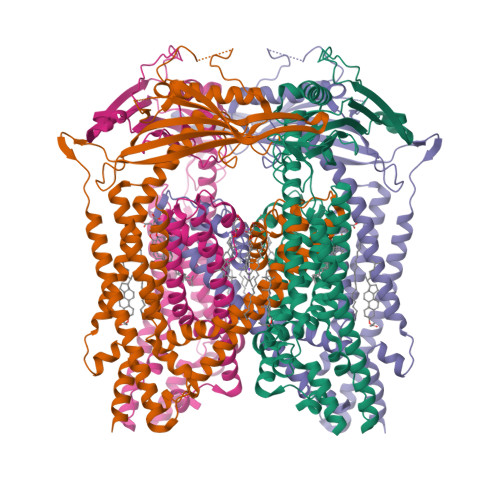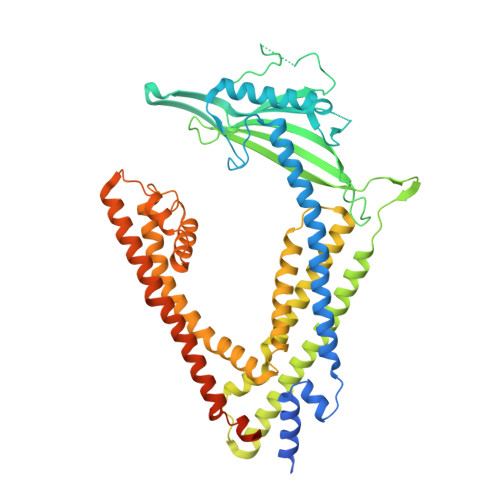Cryo-electron microscopy structure of the lysosomal calcium-permeable channel TRPML3.
Hirschi, M., Herzik, M.A., Wie, J., Suo, Y., Borschel, W.F., Ren, D., Lander, G.C., Lee, S.Y.(2017) Nature 550: 411-414
- PubMed: 29019979
- DOI: https://doi.org/10.1038/nature24055
- Primary Citation of Related Structures:
5W3S - PubMed Abstract:
The modulation of ion channel activity by lipids is increasingly recognized as a fundamental component of cellular signalling. The transient receptor potential mucolipin (TRPML) channel family belongs to the TRP superfamily and is composed of three members: TRPML1-TRPML3. TRPMLs are the major Ca 2+ -permeable channels on late endosomes and lysosomes (LEL). They regulate the release of Ca 2+ from organelles, which is important for various physiological processes, including organelle trafficking and fusion. Loss-of-function mutations in the MCOLN1 gene, which encodes TRPML1, cause the neurodegenerative lysosomal storage disorder mucolipidosis type IV, and a gain-of-function mutation (Ala419Pro) in TRPML3 gives rise to the varitint-waddler (Va) mouse phenotype. Notably, TRPML channels are activated by the low-abundance and LEL-enriched signalling lipid phosphatidylinositol-3,5-bisphosphate (PtdIns(3,5)P 2 ), whereas other phosphoinositides such as PtdIns(4,5)P 2 , which is enriched in plasma membranes, inhibit TRPMLs. Conserved basic residues at the N terminus of the channel are important for activation by PtdIns(3,5)P 2 and inhibition by PtdIns(4,5)P 2 . However, owing to a lack of structural information, the mechanism by which TRPML channels recognize PtdIns(3,5)P 2 and increase their Ca 2+ conductance remains unclear. Here we present the cryo-electron microscopy (cryo-EM) structure of a full-length TRPML3 channel from the common marmoset (Callithrix jacchus) at an overall resolution of 2.9 Å. Our structure reveals not only the molecular basis of ion conduction but also the unique architecture of TRPMLs, wherein the voltage sensor-like domain is linked to the pore via a cytosolic domain that we term the mucolipin domain. Combined with functional studies, these data suggest that the mucolipin domain is responsible for PtdIns(3,5)P 2 binding and subsequent channel activation, and that it acts as a 'gating pulley' for lipid-dependent TRPML gating.
Organizational Affiliation:
Department of Biochemistry, Duke University School of Medicine, Durham, North Carolina 27710, USA.





















